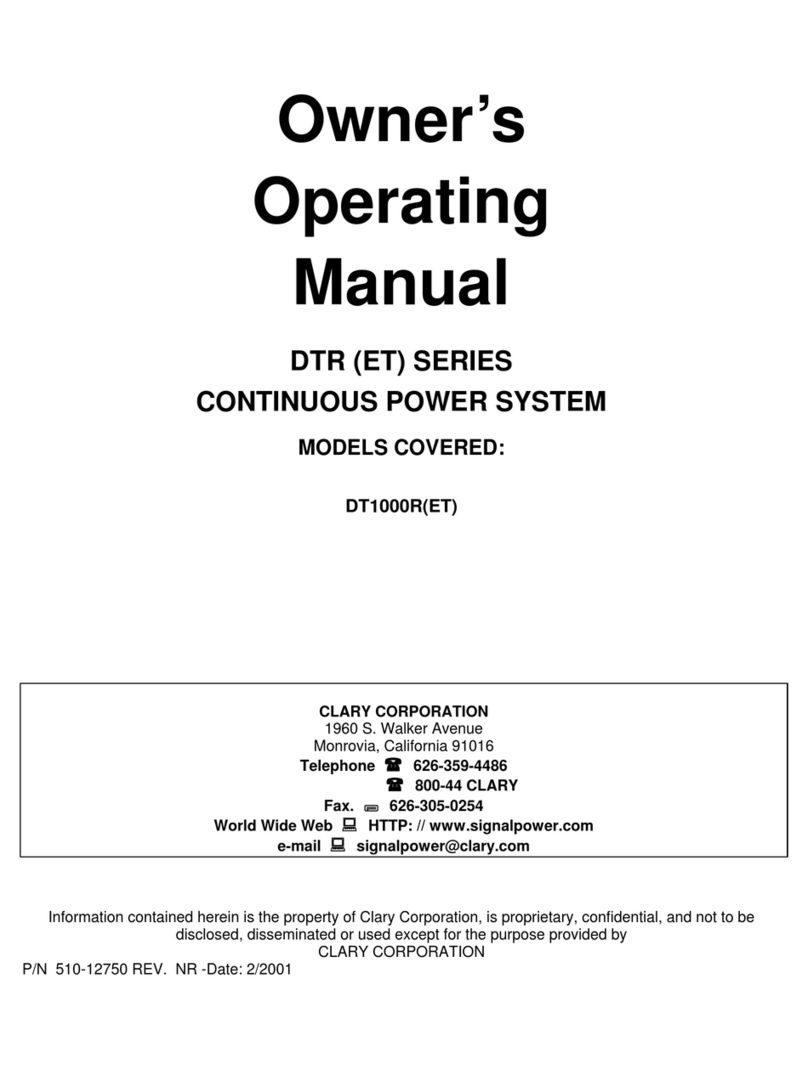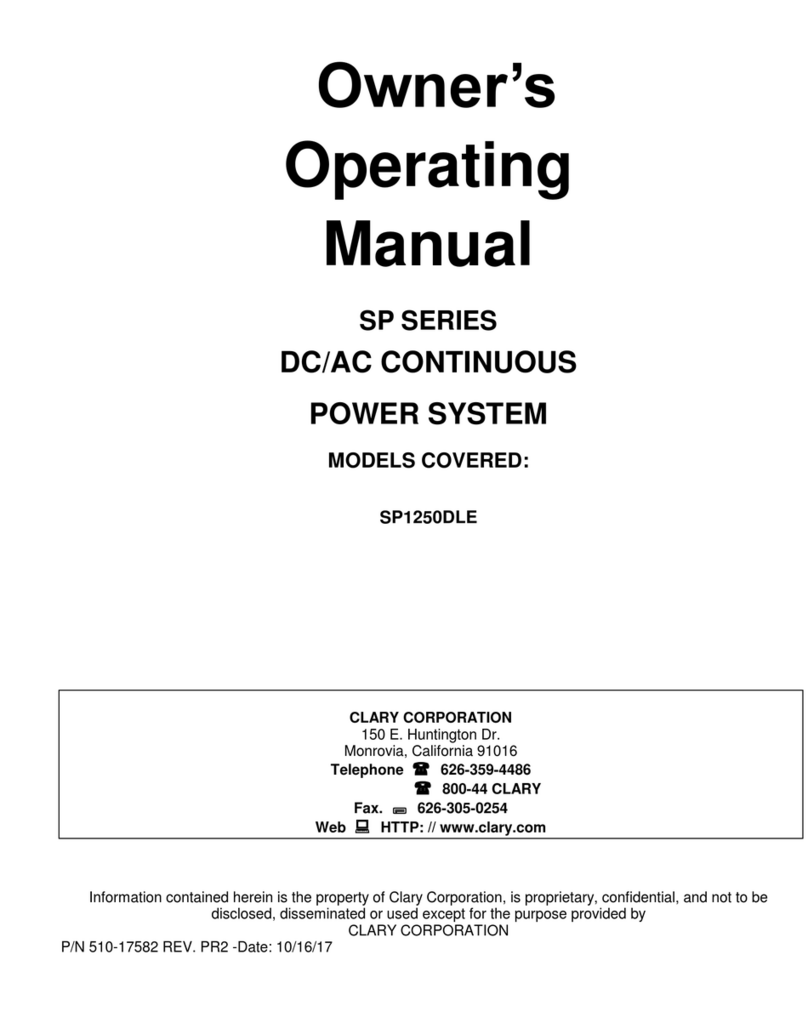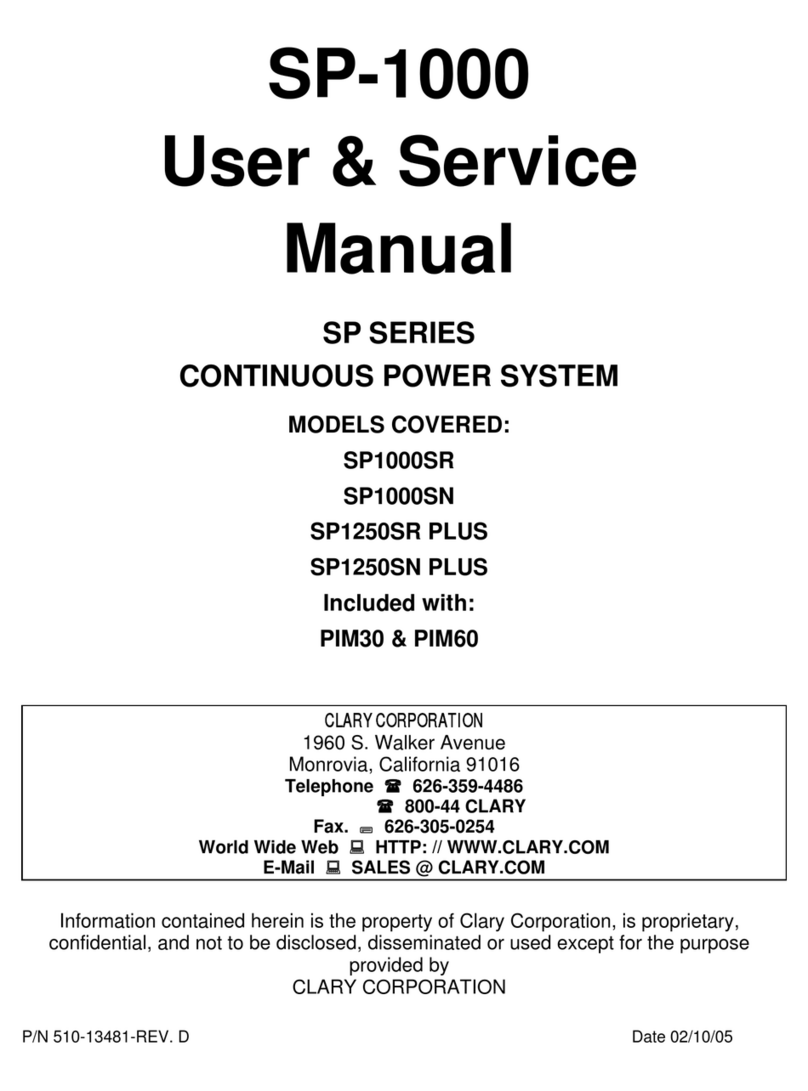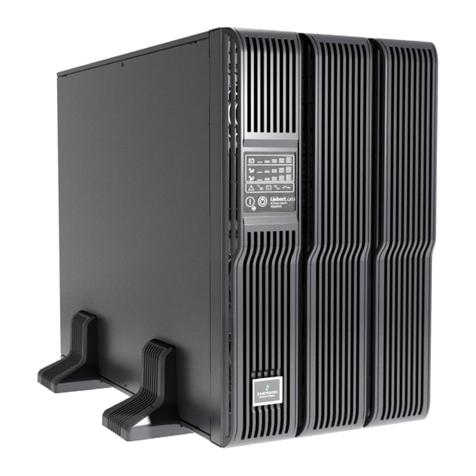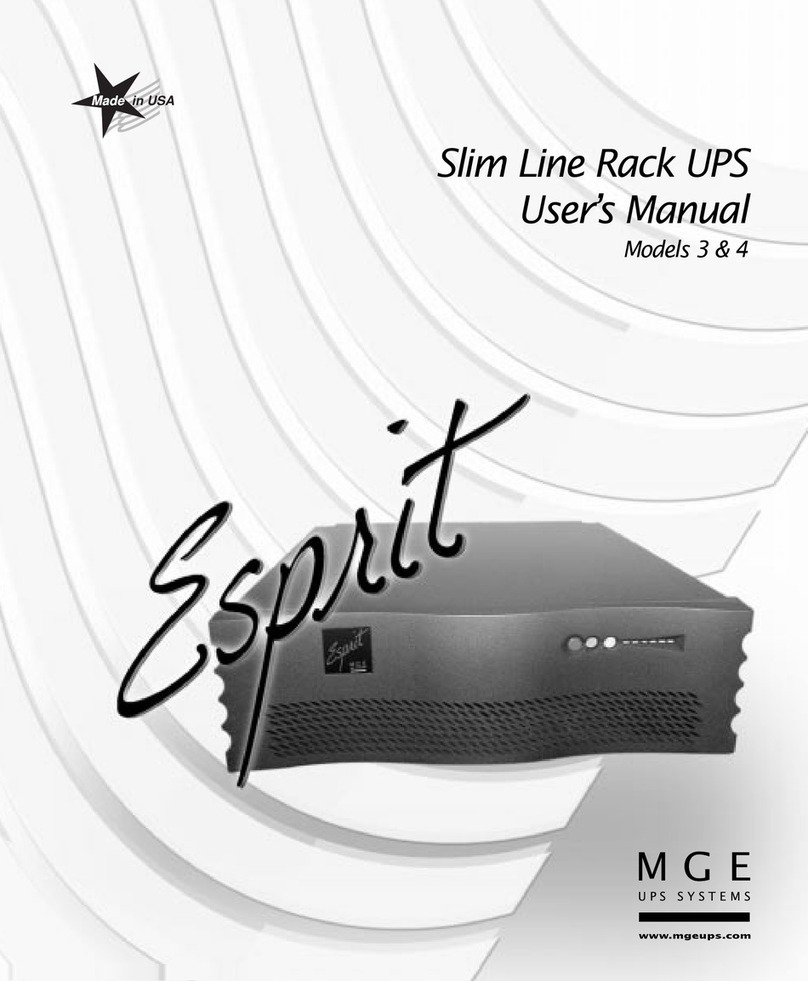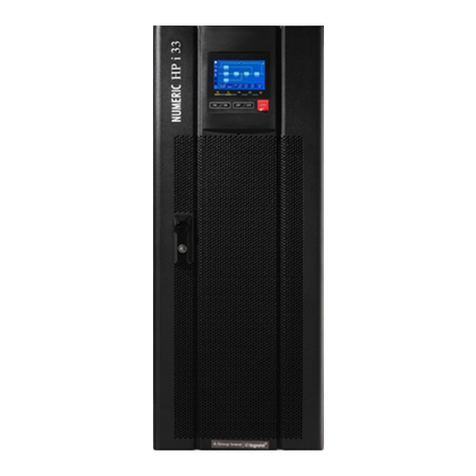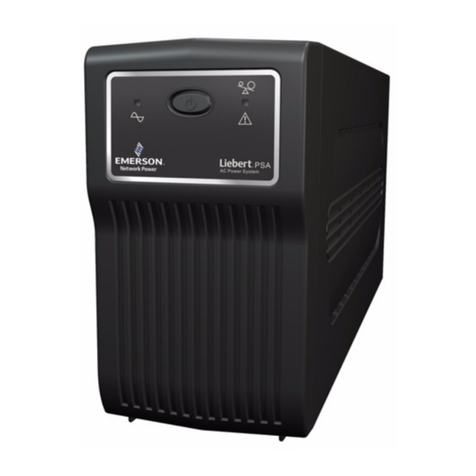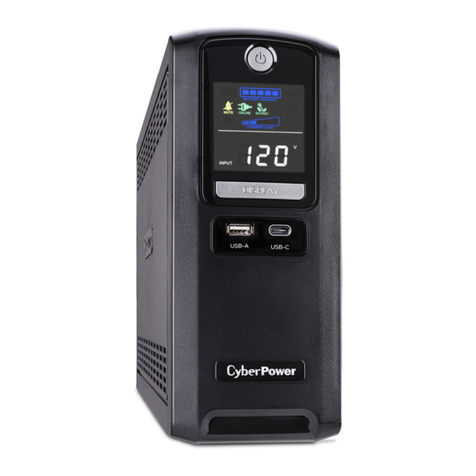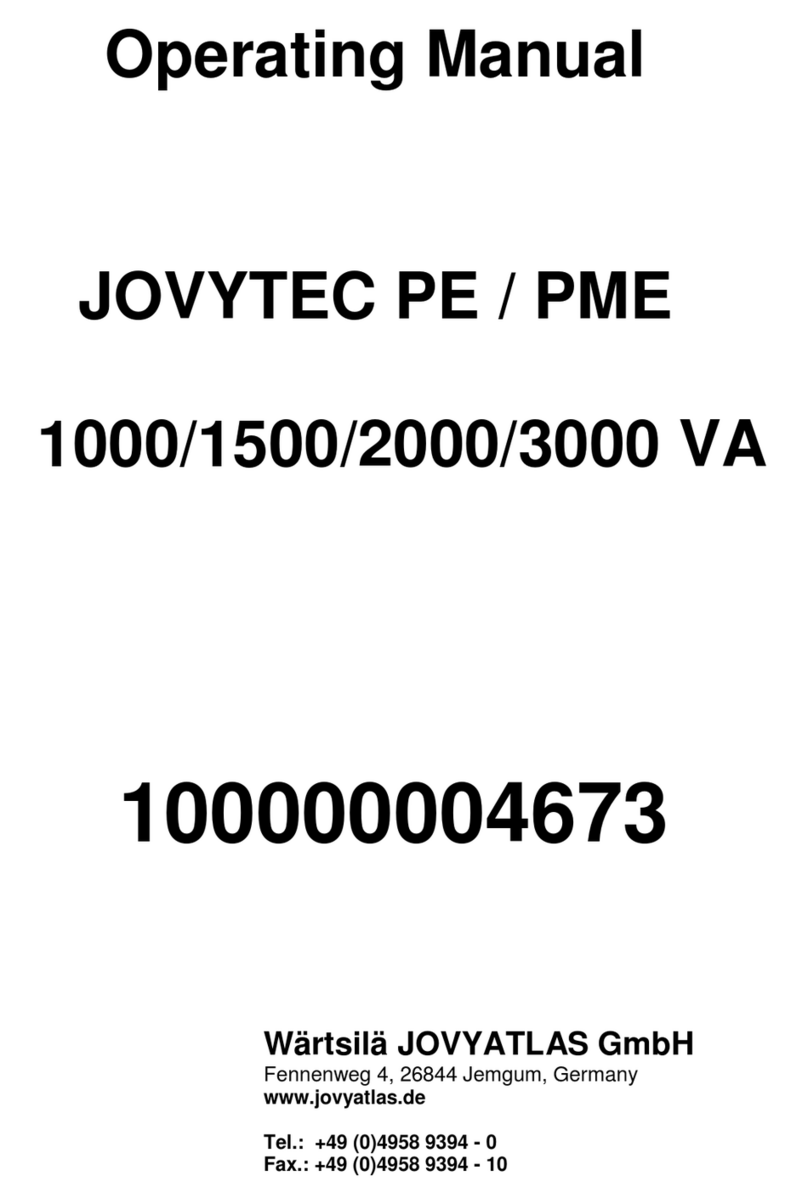Clary Corporation SP2000SR Troubleshooting guide

SP-2000
User & Service
Manual
SP SERIES
CONTINUOUS POWER SYSTEM
MODELS COVERED:
SP2000SR
SP2000SN
Included with:
PIM30 & PIM60
2000VA

SP-2000
User & Service
Manual
SP SERIES
CONTINUOUS POWER SYSTEM
MODELS COVERED:
SP2000SR
SP2000SN
Included with:
PIM30 & PIM60
2000VA
Information contained herein is the property of Clary Corporation, is proprietary,
confidential, and not to be disclosed, disseminated or used except for the purpose
provided by
CLARY CORPORATION
P/N 510-13523-REV.NR 05/22/2003
CLARYCORPORATION
1960 S. Walker Avenue
Monrovia, California 91016
Telephone 626-359-4486
800-44 CLARY
Fax. 626-305-0254
World Wide Web HTTP: // WWW.CLARY.COM
E-Mail SALES @ CLARY.COM

THE CONTINUOUS POWER COMPANY
3
TABLE OF CONTENTS
Section 1 General Description
1.1 Introduction ........................................................................................................6
1.2 Operating Modes................................................................................................7
1.3 Physical Description...........................................................................................9
Section 2 General Characteristics
2.1 General Characteristics....................................................................................14
2.2 Specification.....................................................................................................17
Section 3 Installation and Operations
3.1 Installation........................................................................................................20
3.2 Preparation.......................................................................................................20
3.3 Procedure.........................................................................................................22
3.4 Operation Configuration and Setup..................................................................23
3.5 Operation .........................................................................................................26
3.6 Optional Communication Procedure ................................................................27
Section 4 Adjustments
4.1 Adjustment Overview for DOS Programs.........................................................29
4.2 Adjustment Overview for Windows Programs..................................................34
Section 5 Care and Maintenance
5.1 Safety...............................................................................................................40
5.2 Preventive Maintenance...................................................................................41
5.3 Trouble Analysis...............................................................................................42
5.4 Service and Repair...........................................................................................43
Warranty ...................................................................................................................45

THE CONTINUOUS POWER COMPANY
4
LIST OF FIGURES
Figure 1 Front Panel View .............................................................................................9
Figure 2 Rear Panel View............................................................................................11
Figure 3 PIM To Cabinet Interconnections ..................................................................23
Figure 4 PIM30 Simplified Schematic Diagram ..........................................................24
Figure 5 PIM60 Simplified Schematic Diagram ..........................................................25
Figure 6 Signal/RS232 Pin Assignments ....................................................................28
LIST OF TABLES
Table 1 Front Panel View.............................................................................................10
Table 2 Rear Panel View.............................................................................................11
Table 3 Electrical Specifications..................................................................................17
Table 4 Physical Specifications, UPS Electronics Module...........................................18
Table 5 Physical Specification, PIM Module................................................................18
Table 6 Environmental Specifications..........................................................................19
Table 7 Battery Specifications .....................................................................................18
Table 8 Clary OutPostTM Batteries*..............................................................................18
Table 9 Recommended Installation Equipment...........................................................21
Table 10 Installation Procedure For Traffic UPS ...........................................................22
Table 11 Preventive Maintenance Schedule .................................................................42

THE CONTINUOUS POWER COMPANY
Page 5
“IMPORTANT SAFETY INSTRUCTIONS”
“SAVE THESE INSTRUCTIONS”
This manual contains important safety instructions that should be followed during
installation and maintenance of the UPS and batteries. The instructions should be followed
during installation and maintenance of the UPS and batteries. Be aware of the following
symbols and their meaning as they appear throughout the manual:
Earth Ground Symbol:
On / Off Symbol:
Internal Battery Voltage is 96 VDC.
Maximum Ambient Temperature 74°C.
This unit intended for installation in a controlled environment (temperature controlled, indoor
area free of conductive contaminants).
CAUTION – Do not dispose of batteries in a fire. The batteries may explode.
CAUTION - Do not open or mutilate the batteries. Released electrolyte is harmful to the
skin and eyes. It may be toxic.
CAUTION - A battery can present a risk of electrical shock and high short circuit current.
The following precautions should be observed when working on batteries.
1. Remove watches, rings, or other metal objects.
2. Use tools with insulated handles.
FCC-Rules
This equipment generates and uses radio frequency energy and if not installed and used properly in strict accordance with the
manufacturer's instructions, may cause interference to radio and television reception. All units in this manual have been tested
and found to comply with the limits for a Class A computing device in accordance with the specifications in Subpart J of Part 15
of FCC Rules, which are designed to provide reasonable protection against such interference in a commercial installation.
However, there is no guarantee that interference will not occur in a particular installation. If this equipment does cause
interference to radio and television reception, which can be determined by turning the equipment off and on, the user is
encouraged to try to correct the interference by one or more of the following measures:
Reorient the receiving antenna.
Relocate the UPS with respect to the receiver.
Move the UPS away from the receiver.
Plug the UPS into a different outlet so that the UPS and receiver are on different branch circuits.
If necessary, the user should consult the dealer or an experienced radio/television technician for additional suggestions. The
user may find the following booklet prepared by the Federal Communications Commission helpful:
"How To Identify and Resolve Radio-TV Interference Problems"
This booklet is available from the U.S. Government Printing Office, Washington, DC 20402, Stock No. 004000003454.
!
This symbol indicates that
dangerous voltage
constituting a risk of
electrical shock is present
within the unit.
This symbol indicates that
there are important
operating and
maintenance instructions
in the literature
accompanying this unit. !
CAUTION
RISK OF ELECTRIC
SHOCK DO NOT OPEN

THE CONTINUOUS POWER COMPANY
Page 6
Section 1
GENERAL DESCRIPTION
1.1 INTRODUCTION
You have selected the highest quality power protection system available for your traffic
control devices. You now own a SP Series Traffic UPS (Uninterruptible Power System).
The SP Series is an all Digital Technology UPS product designed and manufactured by
Clary Corporation, the first name in UPS reliability. Clary UPS can be found on naval
warships and submarines, hospital operating rooms, labs, water treatment plants and traffic
intersections. The SP (Signal Power) Series offers a rugged, compact package with
superior features and performance you can depend on.
When power problems occur, there can be no compromising the operations and reliability of
your traffic control devices - - and no compromising public safety. With fully conditioned,
regenerative, sine wave power and military-quality battery backup, the SP Series Traffic
UPS is your complete power solution.
This Owner’s Operating Manual is provided with your new SP Series Traffic UPS. It will
enhance your understanding of the product and its functions.
WE STRONGLY URGE YOU TO READ THIS MANUAL COMPLETELY, PRIOR TO
BEGINNING INSTALLATION OR ATTEMPTING OPERATION.
Studying this manual will save you time and effort in your installation and application, and it
will assure a trouble free installation and startup session, thus enhancing public safety and
the image of your agency.
The illustrations provided will familiarize you with this product’s operating modes and
components. Always operate the unit within the guidelines and specifications provided to
maximize safety and the lifetime of the unit. Your understanding of the product is a key
element in assuring the proper use and effectiveness of the SP Series Traffic UPS.

THE CONTINUOUS POWER COMPANY
Page 7
1.2 OPERATING MODES
Clary’s SP Series Uninterruptible Power Systems (UPS) are designed for powering traffic &
pedestrian indications, plus critical traffic control devices (i.e., controllers, modems, CMU’s,
etc.). The power system consists of three elements, which work together to provide critical
loads with continuous, conditioned, regulated, sinusoidal waveform power that is free from
disturbances such as spikes, surges, brownouts or blackouts. These elements are the:
1. UPS Module – (UPS)
2. Power Interface Module - (PIM)
3. Battery Module
Power loads in the traffic intersection (e.g. LED signals) receive standby backup power
through a highly reliable contactor housed in the PIM. Backup power is achieved with a set
of rechargeable, SVRLA (sealed valve-regulated lead-acid), maintenance-free, AGM
(absorbed glass mat), batteries. The complete UPS system is controlled by an onboard
digital microprocessor at all times.
There are two basic modes of operation:
•Standby Operating Mode
•Continuous Operating Mode
In both modes, the UPS continuously generates 120V AC power. The selected mode
determines when and how the UPS generated power is applied to the loads in the traffic
cabinet.
Standby Operating Mode:
During Standby operation, utility (AC) power enters the PIM and passes through a normally
closed, contactor then directly out to the cabinet power bus, PDA, etc. This utility power is
used to power the intersection until a power disturbance occurs at which time, the contactor
is switched, routing the UPS generated AC power to the cabinet power bus. Typically, the
UPS will then be drawing its power from the battery pack. This operation continues until
good utility power is restored, after which, the contactors switch back to route the utility
power to the loads.
With Standby operation, 0.5 seconds (user programmable from 30ms to 2.5sec) after an
outage is detected, standby power is connected to the system and the Flash Command is
initiated, forcing the cabinet into Flash Mode operation. Depending on the size of the
battery system being used and the loading on the power system, backup power can
continue for several hours.
When utility power returns, (or upon application of generator power) the SP Series UPS
waits 30 seconds to be sure that the utility power has stabilized. After this built-in safety

THE CONTINUOUS POWER COMPANY
Page 8
delay utility power is restored to the cabinet. The battery charger then recharges the
batteries in typically 15 to 20 times the duration of the outage or battery discharge time
(whichever is shorter).
The UPS can be set to force a break in power of 2.5 seconds after utility power returns. This
is optional (not the default) and is used in intersections when a hard-restart needs to be
applied to various devices.
With Standby operation, the ONLY required change to cabinet wiring occurs by the
introduction of the PIM. Removal and Replacement (R&R) of the UPS module is quick and
easy even with traffic control devices (TCD’s) connected to the UPS. If no TCD’s are
plugged into the UPS module (i.e. being used for LED flash backup only), R&R of the UPS
module (for upgrades or in the rare event of UPS failure) can be done without powering
down the cabinet or otherwise affecting cabinet operation in any way.
Continuous Operating Mode:
Continuous operation is used for low power applications such as full LED intersections,
power to the intersection is continuously conditioned and backed up by the UPS. Within the
limitation of the battery capacity, virtually all brownout and power outages are eliminated.
Additional Notes on Operating Modes:
•A generator can also be connected up and fed through the PIM to provide indefinite
auxiliary backup of the intersection. (OPTIONAL)
•The SP Series Traffic UPS is designed for compatibility with, and complete
transparency to, all traffic signal cabinet functions including police panel operation.
Flash Operating Modes:( For PIM 30 Model only)
The PIM includes three (3) sets of normally-open (NO) and normally-closed (NC) relay style
contacts. The contacts are intended to connect to the Flash controllers or other devices in
the traffic cabinet. The contacts are actuated at various times as a means of signaling these
devices of important aspects of current operation. These three relay contact sets are labeled
and switched as follows:
Labeled Usage / Indication Notes
On-Batt UPS is operating from battery power.
Timer UPS has been on battery longer than programmable
threshold. Used as notice of shutdown coming from
low-battery cutoff.
Default time period is 2 hours.
Programmable from 1 to 255
minutes.
Low-Batt UPS is operating from battery and the battery
voltage has fallen below a programmable threshold.
Used as notice of shutdown coming from low-
battery cutoff.
Default voltage is 92V (about
40% capacity.)

THE CONTINUOUS POWER COMPANY
Page 9
1.3 PHYSICAL DESCRIPTION
This section will point out and illustrate the various indicators, functions and controls of the
SP Series UPS. The important attributes of the SP Series unit are numbered to assist you
in locating them on your machine and also to fully explain its function and how it relates to
system operation.
Numbers on the drawing will correspond to the operating component’s name at the bottom
with a brief identification. In the next section, a complete explanation of all numbered items
will be enhanced to ensure you have a full understanding of the operation of this system.
Visual indicators used on the front panel are long lasting, very efficient, light emitting diodes
(LED). When operating the push-button switches, always hold the switch in for at least two
seconds to insure function confirmation. This feature has been implemented into the system
design to avoid inadvertent operation of any of the user-available functions.
Figure 1 is the front view of the model SP2000SN. Model SP2000SR is identical in
operation; however, items 17 through 22 have been repositioned to the rear panel.
Table 1 describes items 1 – 22.
Figure 1: SP2000SN FRONT PANEL VIEW
1
3
10
13
14 16 122
4 9 58
7
11
156
19 21 22
2017 18

THE CONTINUOUS POWER COMPANY
Page 10
Table 1: SP2000SN FRONT PANEL VIEW
SP2000SN FRONT PANEL VIEW
1 SYSTEM POWER SWITCH 12 HOUR METER – Battery runtime meter
in hours
2 INPUT AC LINE FUSE 13 EVENT COUNTER– Counts power
interruptions
3 INVERTER – Inverter operating
indicator 14 RESET – Clears Event Counter back to
zero
4 AC IN – Input line indicator 15 UPS OUTPUT PRESENT – Output
indicator
5 LOAD LEVEL – Output capacity
indicators 16 DC INPUT– Protection circuit breaker
for battery
6 BATTERY LEVEL --
Charge/discharge indicators 17 BYPASS – Protection circuit breaker for
bypass
7 COLD START – DC start switch 18 RS232 – Computer communications
signals
8 COLD START
ACKNOWLEDGE INDICATOR 19 UPS OUTPUT – Continuous power
receptacle
9 ALARM – Fault indicator 20 SIGNAL – Open-collector signal
contacts
10 ALARM SILENT/TEST – Dual
function switch 21 AC IN – Input receptacle for all AC
power
11 ALARM SILENT/TEST
ACKNOWLEDGE INDICATOR 22 DC IN – Input receptacle for all DC
power

THE CONTINUOUS POWER COMPANY
Page 11
Figure 2: SP2000SR REAR PANEL VIEW
Table 2: SP2000SR REAR PANEL VIEW
SP2000SR REAR PANEL VIEW
23 SYSTEM GROUNDING STUD
24 SNMP – (optional) Slot for sophisticated Network monitoring
25 FAST CHARGER MODULE (optional) Slot for extra charging module
26 IDENTIFICATION LABEL – The system Model number and Serial number
are identified here
SUMMARY OF INDICATORS AND CONTROLS
SYSTEM POWER SWITCH - The main control switch that engages utility power to the
entire unit. By activating this switch it initializes normal operation.
NOTE – The DC INPUT circuit breaker must be “ON” before activating the
System On/Off switch.
DC INPUT - A two pole, 30A circuit breaker used to connect the battery to the internal UPS
electronics. It also protects against over-current situations in the battery circuit.
INPUT AC LINE FUSE - The input line protection device to limit excessive current draw to
the system.
!
17 16
19 21 22
15 23
2426 25

THE CONTINUOUS POWER COMPANY
Page 12
INVERTER - This indicator identifies the status of the regenerated, conditioned protected
output power. This indicator will stay ON as long as protected power is available from the
power inverter generator.
AC IN - The utility input indicator that identifies status of the line voltage. If the line voltage
is within the specified range, it will remain lit. If the AC input is out of range, but present,
the indicator will slowly blink.
LOAD LEVEL - This is the system output capacity status bar. The number of LEDS
illuminated indicates an approximate percentage of system load. All green LEDS
illuminated would indicate full load. The top red LED illuminates on over-loads.
BATTERY LEVEL - This is the battery status bar graph. During normal operation, this bar
graph will show the charging of the battery; all indicators lit will represent a fully charged
battery. During battery operation, this bar graph represents a discharge meter indicating
less battery time available as each light goes OFF.
COLD START - A momentary push-button switch to activate the system in the event no
utility power is available. The system will be allowed to start up by using power from the
battery. Depress this switch, the indicator above it will light, and hold it in until the audible
alarm beeps once. The system will maintain a load for a period of time depending upon the
condition of the battery. DC INPUT breaker must be ON.
ALARM - This is a fault indicator that will light in the event that the inverter generator is non-
operable. This could be due to an over-temperature situation or an inverter malfunction.
ALARM SILENT / TEST - A momentary push-button switch that controls two different
functions depending on the mode of operation. In the normal mode of operation, if this
switch is depressed and held in, the above indicator will blink. Once it stops blinking, the
unit will perform an internal 1 to 2 minute battery check. Once the test is completed, if the
battery is below standards, the system will indicate that the battery needs replacing. The
system will not run this battery test unless the battery is detected as fully charged. The
audible alarm on the unit will be disabled. This is set at the factory.
NOTE - Cold Start and Alarm Silent switches must be held in for at least two
seconds to engage their function. This is to prevent any inadvertent switch
operation.
!

THE CONTINUOUS POWER COMPANY
Page 13
HOUR METER - A cumulative run time meter that shows the total battery run time for the life
of the unit.
EVENT COUNTER - A meter that counts the number of times the system has gone into
battery operation. The Event Counter also increments each time the unit is turned off and
on by the SYSTEM POWER SWITCH.
RESET- A momentary pushbutton switch that resets the Event Counter to zero.
UPS OUTPUT PRESENT - A green LED that is illuminated to indicate fully conditioned and
continuous output AC power is present at the output receptacle.
RS232 - A RJ45 connector that outputs true RS232 communications signals.
UPS OUTPUT - A NEMA type duplex, 5-20R output connector that provides continuous
power. This receptacle is connected to the bypass line when the inverter is not running.
BYPASS - A 20A protective pop out circuit breaker in the bypass line of the continuous
output circuit. Protects the UPS OUTPUT 5-20R connector noted above.
SIGNAL - A DB-9 subminiature, female connector that outputs the open-collector signal
contacts that generate a low state during utility interrupt, low battery and inverter off
conditions.
AC INPUT - A circular locking connector provided for AC power to and from the UPS.
DC INPUT - A circular locking connector provided for battery power to the UPS.
NOTE – For safety purposes, these AC INPUT and DC INPUT connectors are
tied into an interlock system which ensures that if either connector is
disconnected, the unit will discontinue operation.
SYSTEM GROUNDING STUD - A 10-32 x 3/4 threaded stud for system grounding
termination.
!

THE CONTINUOUS POWER COMPANY
Page 14
Section 2
GENERAL CHARACTERISTICS
2.1 CHARACTERISTICS
Overview
The Clary SP Series Traffic UPS is a turnkey, true on-line, power conditioner and battery backup or
uninterruptible power system (UPS) designed for the extreme environments found in traffic cabinets
(-40 to + 74 deg C).
The Clary SP Series, with its standard 41Ahr battery pack, is capable of operating, a full LED
intersection for over an hour at 1400W (watts) output. A typical intersection consuming 450W can
be powered for approximately 4 hours. In Red-Flash operation, which consume only about 300W,
over 6 hours of backup is possible. These times assume fully charged batteries at an ambient
temperature of 25C.
Operation
The Traffic UPS is capable of producing – simultaneously -- full regenerated and regulated, true
sine wave power, with standby and continuous AC outputs. The Power Interface Module (PIM) is
the link between the utility power, the UPS power, and the loads.
When utility power is adequate, the PIM routes that power to the loads. Upon loss of utility power
the Traffic UPS routes UPS generated power to the loads. In the event of UPS failure and/or battery
depletion, the PIM will ensure that the UPS will drop out and, return to utility power when available.
The traffic control system will then default to normal operational mode.
The Power Interface Module (PIM) enables removal and replacement of the Traffic UPS without
shutting down the traffic control system (i.e. “hot swap” capability). Connectors are equipped with a
“safety interlock” feature.

THE CONTINUOUS POWER COMPANY
Page 15
For 170 type cabinets, upon loss of power the Traffic UPS can actuate the existing Flash Transfer
Relays (FTRs) and Mercury Contactor (MC) to allow the traffic control system to put the cabinet into
Flash Mode operation.
Existing Flasher Modules and Flash Transfer Relays are utilized. The Traffic UPS does not
duplicate or take over flash operation or flash transfer relay functions.
The Traffic UPS is capable of providing continuous, fully regenerated, conditioned, regulated,
sinusoidal (AC) power to selected devices such as signal controllers, counters, modems,
communications hubs, NTCIP adapters, video equipment, etc.
To facilitate emergency crews and police activities, the Traffic UPS is compatible with police panel
functions (i.e. “Signals OFF” switch must kill power to the field wiring even when on UPS/Battery
power).
Utility Voltage Windows and Battery Operation
The UPS operates from utility if the utility voltage is between 85 and 135 vac. When the utility falls
below 85 vac or climbs above 135 vac the UPS operates from the batteries. In the Standby modes
of operation, the PIM is activated when the utility is below 100 +/- 2 VAC or above 130 +/-2 VAC.
The UPS does draw from the batteries until the voltage is out of the previously stated limits.
There is a programmable noise rejection window, which specifies how the UPS system treats small
time-duration power glitches. Power disturbances must last at least 40ms to trigger change in
operation. Small disturbances on this order occur frequently due to many different conditions.
These disturbances, however, are not detrimental to traffic controllers. To minimize nuisance
switching this noise rejection window is implemented.
After operating in Standby mode, the UPS monitors the utility voltage. When this voltage is restored
to adequate conditions for 30 seconds, the UPS returns utility power to the cabinet.
Description
The Traffic UPS consists of three major components, the UPS Power Module, the Power Interface
Module, and the Battery System.
The UPS Power Module consists of the following:
•True on line, double conversion, pure sine wave, high frequency inverter utilizing IGBT
technology.
•Local individual indicators for battery status, load levels, battery run-time, and event counter.
•One DB9F connector (Signal) and a RJ45 connector (RS232) for remote signal alarms and true
RS232 monitoring and remote communications.

THE CONTINUOUS POWER COMPANY
Page 16
•Multi-stage, temperature compensated battery charger.
The Power Interface Module 30 contains a magnetic contactor for back feed protection and to
facilitate hot swapping of the electronics module. It is the primary interface between the UPS and
the cabinet.
The PIM houses the relays connected to the Flash controllers. These electro-mechanical relays are
controlled by signals carried to the PIM from the UPS’s SIGNAL port. These logic signals are
converted through optical switches into 120VAC levels, which are then used to switch the electro-
mechanical relays.
The Power Interface Module 60 contains two mercury contactors for back feed protection and to
facilitate hot swapping of the electronics module. The PIM 60 does not include the electro-
mechanical relays for the Low Battery and Timer function.
The Battery Module. The battery is comprised of one or more strings of 8 individual 12V batteries
connected in series for a total string voltage of 96V DC nominal.
The batteries are extreme temperature, deep cycle, AGM/VRLA (Absorbed Glass Mat/ Valve
Regulated Lead Acid) batteries that have been field proven and tested by the U.S. military. The
OutPostTM batteries supplied by Clary Corporation are certified to operate at extreme temperatures
from –40°C to +74°C.
The batteries are provided with appropriate interconnect wiring harness. Optional battery mounting
trays and brackets are available.
The interconnect cable connects to the base module via a quick-release circular connector.
The UPS module includes a charger that replenishes the Battery Pack whenever possible and
required. This charger operates with a maximum charging current of 0.6A at 96V. An optional “Fast
Charger” module plugs into the UPS module to increase the charging current to over 3.5A at 96V.
Mounting/ Configuration
NEMA Style: mounting method is shelf-mount or wall-mount.170 Style: Mounting method is 19”
rack-mount. Shelf angles or rails, typically supplied by others, are available as optional
accessories.
For purposes of safety and proper operation, the circular battery connector has interlocking pins to
prevent turn-on if battery system is not connected, and to shut off the UPS should the battery
system be disconnected.
Battery construction includes heavy-duty, inter-cell connections for low-impedance between cells,
and heavy-duty plates to withstand shock and vibration.

THE CONTINUOUS POWER COMPANY
Page 17
2.2 SPECIFICATIONS
The various specifications of the UPS system are provided in the following tables.
Table 3: ELECTRICAL SPECIFICATIONS
Electrical Specifications
Input Specification
Nominal Input Voltage 120 VAC, Single Phase
Input Voltage Range 85 VAC to 135 VAC
Input Frequency 50 or 60 Hz (+/- 5%)
Input Configuration 3 Wire (Hot, Neutral & Ground)
Input Current (Max. draw) 14.3 amps, Power-Factor Corrected
Input Protection Input Fuse (25 amps)
Output Specification
Nominal Output Voltage 120 VAC, Single Phase
Power Rating 2 kVA (2000VA/1400W), 16.7Amps
Output Voltage Regulation +/- 2% for 100% step load change and from
High battery to Low battery condition
Output Frequency 50 or 60 Hz (+/- .5%) unit not in sync.
Output Configuration Keyed, circular connectors and duplex Receptacle.
Output Wave Form True Sine wave
Overload capability 110% for 10 minutes 200% for ½ second
Fault clearing Current limit and automatic shutdown
Short circuit protection Current limit and automatic shutdown
Efficiency 90% at full load (on utility)
Load Power Factor .7 lagging through unity to .7 leading

THE CONTINUOUS POWER COMPANY
Page 18
Table 4: PHYSICAL SPECIFICATIONS, UPS ELECTRONICS MODULE
Physical Specifications, UPS Electronics Module
Dimensions:
Rack-mount units:
Width = 19”, Depth = 13”, Height = 5.25” (3U)
Shelf-mount units:
Width = 19”, Depth = 13”, Height = 5.25”
Wall-mount: / Unistrut Rail mount units:
Width = 19”, Depth = 13”, Height= 5.25”
Weight: UPS: 25 lbs., Shipping weight: 30 lbs.
Table 5: PHYSICAL SPECIFICATIONS, PIM MODULE
Physical Specifications, PIM Module
Dimensions:
Width = 6”, Depth = 2.8”, Height = 9”
Weight: PIM: 5 lbs., Shipping weight: 5 lbs.
Table 6: ENVIRONMENTAL SPECIFICATIONS
Environmental Specifications
Temperature: - 40°C to +74°C.
Table 7: BATTERY SPECIFICATIONS
Battery Specifications
Temperature: – 40°C to +74°C.
Ampere-Hour ratings: see Table 8
Hydrogen gas emissions: meets Mil-Spec #MIL-B-8565J

THE CONTINUOUS POWER COMPANY
Page 19
Table 8: CLARY OutPostTM BATTERIES*
Estimated Runtime
(Per set @ 77°F / 25°C)
(New Batteries, fully
charged)
Unit
Weight
Overall Dimensions
Per Battery Inches (cm.)
Clary
Part. No.*
Volts/
A-hrs.
300
Watts 700
Watts 1400
Watts Lbs.
(Kg.)
Length
L
Width
W
Height
H
OP96C
(Set of
Eight
Batteries)
12
VDC/
41 AH
6.5
Hrs.
2.5
Hrs.
1
Hr.
29
(13.2)
7.68
(19.6)
5.15
(13.1)
7.9
(20.1)
*OP96X battery sets include eight (8) batteries per set. Wired in series, each set provides 96 VDC.
Lower/Higher AH capacity batteries, allowing less or more runtime, are available on special order.
Call factory for more information.
Communications, Controls & Diagnostics
Alarm Function Monitoring: The traffic UPS comes standard with a DB-9F connector with open
collectors (40 V @ 20 mA) indicating On-Battery, Low-Battery, Timeout on-battery and Alarm.
A separate RS232 Interface is provided via a RJ45 connector allowing full, interactive, remote
computer monitoring and control of the UPS functions via standard UPS protocols.
Front Panel controls: Power ON, Cold (DC) Start, Alarm Silence, Battery Test, Bypass Circuit
Breaker, and DC/Battery Circuit Breaker.

THE CONTINUOUS POWER COMPANY
Page 20
Section 3
INSTALLATION AND OPERATIONS
3.1 INSTALLATION
The UPS system is typically rack-mounted in standard traffic cabinets. When determining how to
position the UPS system inside your cabinet, the following requirements MUST be met.
•The installation site MUST maintain an ambient air temperature of less than 165oF (74oC).
•The air inlets, vents and fan MUST NOT be obstructed or blocked in any way. There MUST
BE clearance around each air-inlet and vent.
•The air should remain free from excessive dust and chemical fumes.
•Total power requirements to be drawn from the UPS must not exceed the rated power of the
UPS.
Please note these items when designing the UPS system’s mounting hardware:
•The front panel is designed to fit in a standard 19" rack. This panel fills a 5.25-inch slot.
3.2 PREPARATION
Installation of the SP Series Traffic UPS must be preceded by careful preparation. The following
steps are typical:
•Ensure that the Installation Requirements will be met. (See previous section).
•Read this manual thoroughly.
•Assemble wiring diagrams.
This manual suits for next models
1
Table of contents
Other Clary Corporation UPS manuals
Popular UPS manuals by other brands

Xtreme Power Conversion
Xtreme Power Conversion XVT 600VA User & installation manual
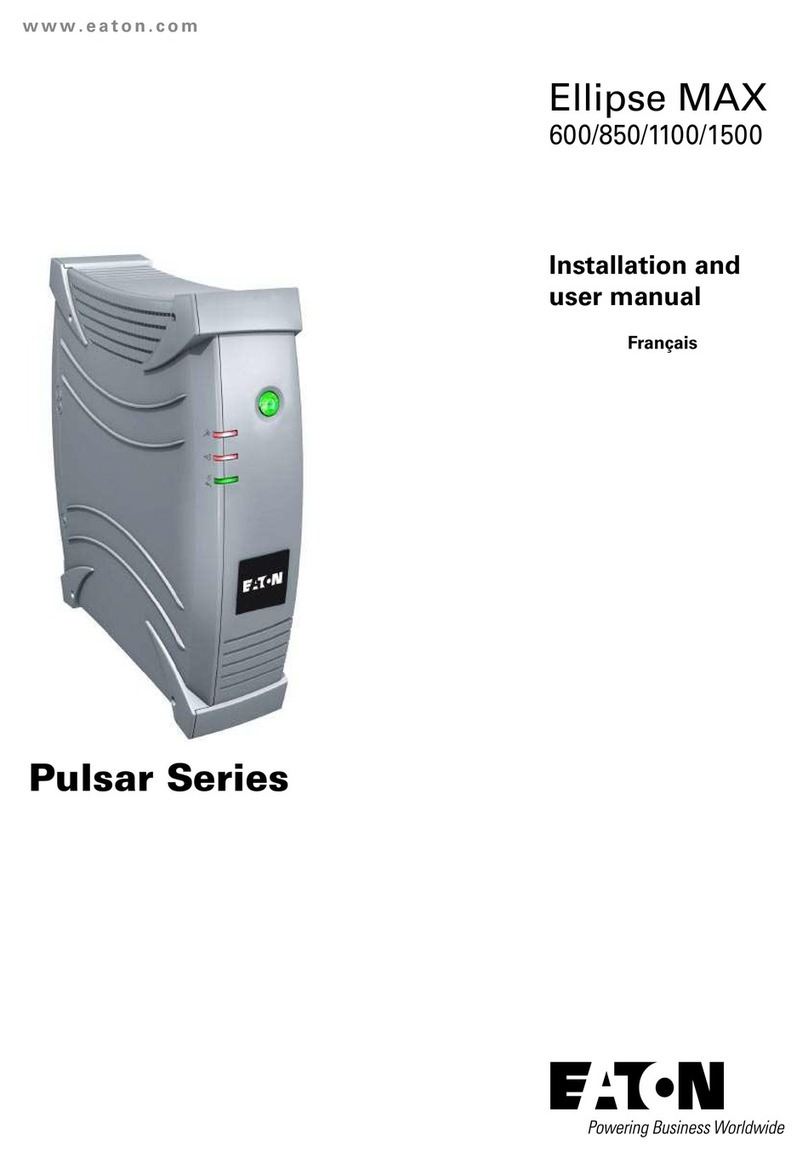
Eaton
Eaton Ellipse MAX 600 Pulsar Series Installation and user manual

Eaton
Eaton Power Xpert PXGX Quick start instructions
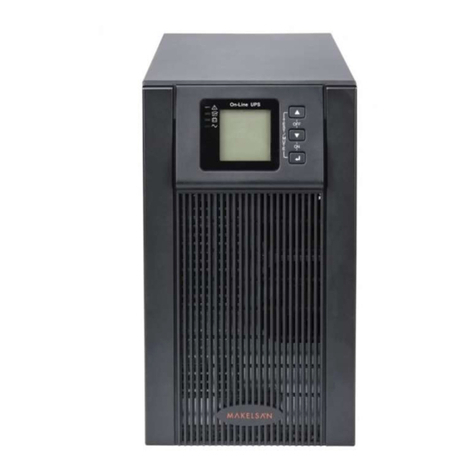
MAKELSAN
MAKELSAN POWERPACK PLUS SERIES user manual

Atek
Atek Blazer Vista 400 VA user manual
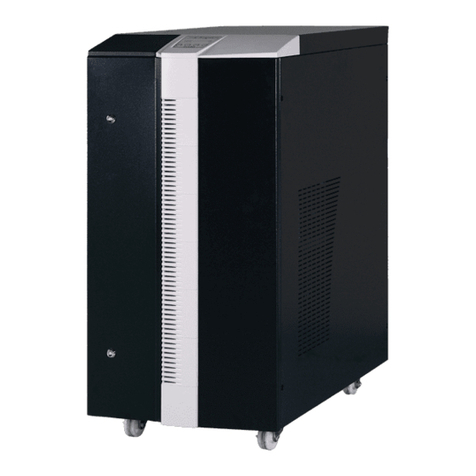
inform
inform SAVER PLUS DSP SERIES user manual
